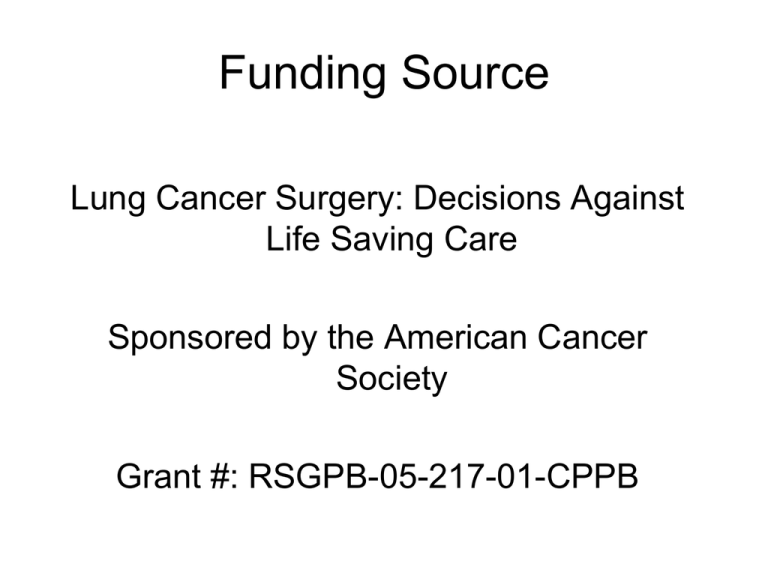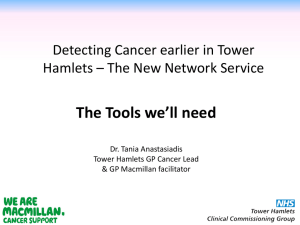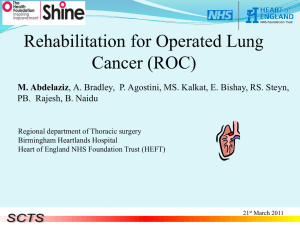
Funding Source
Lung Cancer Surgery: Decisions Against
Life Saving Care
Sponsored by the American Cancer
Society
Grant #: RSGPB-05-217-01-CPPB
Racial Disparities in the
Treatment
of Early Stage Lung Cancer:
Which Interventions Will
Work?
Case 1
A 53 year old African-American man
presented to the emergency department
with cough. A CXR was performed that
revealed a 2.5 cm pulmonary nodule. A
CT was immediately obtained and showed
the nodule to be spiculated and not
calcified. The patient was told that he
might have a cancerous tumor and was
referred for a follow-up appointment.
Case 1
His cough resolved, so he did not keep the
appointment. He returned 6 months later
and had an 8cm tumor on CXR with
mediastinal invasion.
***What could have been done
differently?
Case 2
A 67 year old smoker who had a CXR for
a persisting cough after a URI was found
to have a 2.1 cm lung nodule. Also has
multiple blebs surrounding the nodule
precluding a needle biopsy. PET CT
shows the nodule is hot (18 SUV). There’s
a 1.6 cm ipsilateral, hilar node on the CT
that does not light up on the PET.
Case 2
Other pertinent clinical data:
• FEV-1 45% of predicted
• Has known CAD with an LAD stent 6
months ago (no current sx) and a 50-60%
RCA lesion
• EF – 35 to 40%
• Baseline Creatinine 2.4
***Surgery yes or no?
Proportion responding that they believe that clinically similar patients receive different care on
the basis of race/ethnicity by proximity to practice (n=344)
Lurie, N. et al. Circulation 2005;111:1264-1269
Why Study Early Stage Lung
Cancer?
•
Fatal Disease
• Surgery only reliable chance of cure
• No treatment only 6% survive five-years
• A few absolute contraindications are defined
• Have to have strong reasons to refuse or recommend
against
• Administrative data reveal lower surgical
rates and survival for AfricanAmericans diagnosed with Stages I and
II, non-small cell lung cancer
Bach et al. Racial differences in the treatment of early
stage lung cancer. N Engl J Med 1999;341:1198.
Race
Lung Cancer
Surgery
5-year
survival
Caucasian
77%
34%
AfricanAmerican
64%
26%
44 excess deaths per 1000 lung cancer
cases due to decisions against surgery!
Survival of Medicare Beneficiaries 65 Years of Age or Older Who Were Given a
Survival of Medicare Beneficiaries 65 Years of Age or Older Who Were
Given a Diagnosis of Stage I or II Non-Small-Cell Lung Cancer between
1985 and 1993, According to Treatment and Race
Bach, P. B. et al. N Engl J Med 1999;341:1198-1205
Lathan et al. J Clin Onc 2006;24:413-418
• OR for Black patients to receive staging
procedures compared to Caucasians
0.75
• OR for Black patients who were actually
staged to receive surgery compared to
Caucasians
0.55
Fig 1. Reasons recorded in Surveillance, Epidemiology, and End Results for why surgery was not
performed among patients who had undergone invasive staging
Lathan, C. S. et al. J Clin Oncol; 24:413-418 2006
Copyright © American Society of Clinical Oncology
• Administrative data controlled for
insurance, income, and co-morbidities.
• No specific reasons for treatment
disparity despite near certain death
within 4 years post-diagnosis
Reference – Prospective Cohort Study
Cykert, Dilworth-Anderson,Monroe, et al.
Factors associated with decisions to
undergo surgery among patients with
newly diagnosed early stage lung cancer.
JAMA 2010; 303:2368-2376.
Methods
• 5 communities
• Pulmonary, Oncology, Thoracic Surgery,
ED, and Generalist Practices
• Direct referral vs chest CT review protocol
Inclusion Criteria
• > 18 years old
• Tissue diagnosis of non-small cell lung
cancer or > 60% probability using a
Bayesian Model
• Clinical / Radiological Stage I or II
disease
• English Speaking
Timing of Enrollment
• Patient informed of the diagnosis of
definite or probable lung cancer
• Survey administered verbally by trained
RA before treatment plan established
The Questionnaire
106 items Including:
•
•
•
•
•
Demographics
SF-12
Mental Adjustment to Cancer Scale
Trust
Perceptions of provider-patient
communication
•
•
•
•
•
•
“Exposure to air”
Perceived certainty of diagnosis
Attitudes about lung cancer
Dyspnea
Decision participants
Religiosity
Chart Abstraction
•
•
•
•
•
•
Timing: At least 4 months after diagnosis
Surgery: Yes / No and Date
PFT’s
Co-Morbid Diagnoses
Clinical Stage
Surgical Stage
Statistical Analysis
• Primary Outcome: Lung Cancer Surgery
Within 4 Months of Diagnosis
• Independent variables a priori in models:
- demographics
- SF-12 component scores
- tissue vs presumptive diagnosis
- perception of diagnostic certainty
- Mental Adjustment to Cancer scales
- “air exposure”
- trust
- co-morbid conditions
• Variables entered after bivariate
comparisons if p < 0.1
- attitudes about lung cancer
- religiosity
- other decision participant
- perceptions of provider-patient
communications
Results
• Patients enrolled – 437
- 7 patients not Caucasian or AA
- 32 with advanced cancer
- 6 with benign dx
- 6 with FEV-1 < 25% predicted (no
surgeries below this level)
• 386 met entry criteria and remained
eligible for lung resection surgery
Results
• 67 percent (N = 257) with biopsy proven
diagnosis at enrollment
- 62% surgical resection
• 33 percent CT-defined probable disease
- 64% surgical resection
• 88 percent tissue diagnosis confirmed
Results: Demographic Data
Characteristic
Percent
African-American
29
Married
64
Male
56
Insured
92
Education > High School
35
Median Age
66 yrs (range 26 to 90)
4 Month Surgery Rates
• All enrollees (N = 386)
Caucasian
66%*
African-American 55%
*p = .05
4 Month Surgery Rates
• Tissue confirmed only (N = 339)
Caucasian
75%*
African-American 63%
*p = .03
Lung Surgery Rates – Bivariate
Comparisons
Percent Surgery if
Agree
Percent Surgery if
Disagree
Faith alone can cure
disease
52
70
One or more family
members will have to
approve surgery
57
66
If I have surgery and the
cancer is exposed to air
it will spread
53
70
My quality of life in 12
months will be better if
I have lung cancer
surg.
75
41
My doctor listened to
me when I had
something to say
71
36
Regression Analysis - All Patients
Independent
Variable
AA Race
Comm. Score
(5 of 25 less)
Belief QOL
worse in 12
months + surg
Odds Ratio for 95% Confidence
Lung Ca Surg Interval
.75
.57 – .99
.42
.32 – .74
.27
.14 – .50
Regression Analysis - All Patients
Independent Odds Ratio for 95% Confidence
Variable
Lung Ca Surg Interval
Top quartile
.32
.20 – .51
age (>73 yrs)
Bottom quartile
.51
.28 – .91
MCS of SF-12
Religiosity
.56
.39 – .79
(Faith alone q)
Regression Analysis - African
Americans
Independent
Variable
Comm Score
(5 of 25 less)
Co-morbid illness
2 or more
No Regular
Source of Care
Odds Ratio for
Lung Ca Surg
95% Confidence
Interval
.27
.15 – .51
.04
.01 – 0.25
.20
.10 - .43
Regression Analysis - AfricanAmericans
Independent
Variable
Odds Ratio for
Lung Ca Surg
Belief QOL worse
in 12 months with
surg
Trust Scale – 10
point increase*
* The Trust Paradox
95% Confidence
Interval
.25
.08 – .79
0.54*
.35 – .85
Regression Analysis – White Patients
Independent
Variable
Co-morbid
illness 2 or more
Odds Ratio for
Lung Ca Surg
.45
95% Confidence
Interval
.10 – 2.0
Comm Score (5 of
25 less)
.47
.24 – .93
Worse QOL in 12
months with surg
.25
.17 – .37
Trust Scale – 10
point increase
1.0
.76 – 1.4
Regression Analysis – White Patients
• No Regular Source of Care
OR 1.3, 95% CI .32 – 5.3
Co-morbidities
• Strand TE et al. Risk factors for 30-day
mortality after resection of lung cancer and
prediction of their magnitude. Thorax
2007;62:991-7.
- Minimal effect of Charlson Co-morbidity
Index on 30 day survival (3.8% CCI of
0, 5.8% CCI 1-2, only 6.5% of patients
had CCI > 3)
Co-morbidities
• Battafarano et al. Impact of comorbidity on survival after
surgical resection in patients with stage I non-small cell
lung cancer. Journal of Thoracic and Cardiovascular
Surgery 2002;123:280-7.
- Average 3-year survival – no comorbidities
86%
- Average 3-year survival – severe comorbidities 70%
- Average 3-year survival without surgery*
* Bach N Engl J Med 1999; 341:1198
10 – 15%
Results
• N = 386
• 66 deaths at one year
• 100% follow up
• AA patients 4.4 years younger than W
• Average age of survivors 65.6 years; average
age died 70.1 years (p = 0.002)
Results
Characteristic
Percent Mortality at One-Year
AGE*
> 66 years
24
< 66 years
10
RACE
African-American
17
White
17
COMORBIDITIES*
>2
31
<2
15
LUNG CANCER SURGERY*
Yes
12
No
25
*P < 0.05
-------------------------------------------------------------------------pt_died |
Odds Ratio Std. Err.
z P>|z| [95% Conf. Interval]
-------------+---------------------------------------------------------------d_demomari2 | .5643592 .175378 -1.84 0.066 .3069302 1.037699
medincy1 |
.8405706 .2744353 -0.53 0.595 .4432697 1.593971
d2_demoedu | 1.124134 .350837 0.37 0.708 .6097647 2.072403
d_demorace | 1.097042 .3950806 0.26 0.797 .5415986 2.222126
age50th |
3.445103 1.14981 3.71 0.000 1.791067 6.626626
dxdiabetes |
1.255789 .4429175 0.65 0.518
.629068 2.506894
dxcoronary~e | 1.121822 .3708338 0.35 0.728 .5868777 2.144374
demosex |
1.288879 .3964429 0.83 0.409 .7053315 2.355217
had_surg |
.5193712 .1558765 -2.18 0.029 .2884102 .9352874
rscy |
.6981523 .3100482 -0.81 0.418 .2923701 1.667122
dxhyperten~n | .5987609 .1868083 -1.64 0.100 .3248522 1.103624
comorbtotal3 | 2.785209 1.175041 2.43 0.015 1.218282 6.367485
comorbtotal1 | 1.454711 .4823543 1.13 0.258 .7595123 2.786242
------------------------------------------------------------------------------
Results
• Factors associated with one-year mortality
for early stage lung cancer
- Age over 66 (OR 3.4, 1.8 – 6.6)
- >2 comorbidities (OR 2.8, 1.2 – 6.4)
- lung cancer surgery (OR 0.52, 0.29 –
0.93)
Conclusions
• Excluding patients with PFT defined absolute
contra-indications, disparities in treatment for
early stage, non-small cell lung cancer remain
• The impact of poor communication is apparent
in both White patients and African-Americans
• Lack of a regular source of care exacerbates the
effect on African-Americans
Conclusions
• Co-morbid conditions are markedly
associated with decisions against surgery
for African-American patients
• This impact is NOT apparent with White
patients
• This finding suggests a systematic or
implicit bias when considering higher risk
African-American patients for lung cancer
surgery
Implicit (Unintended) Bias
• Schulman et al. The effect of race and sex on
physicians' recommendations for cardiac
catheterization. N Engl J Med 1999;340:618-26.
• Green et al. Implicit Bias among Physicians and
its Prediction of Thrombolysis Decisions for
Black and White Patients. Journal of General
Internal Medicine 2007;22:1231-8.
Possible Solutions
• Know that disparities (beyond what is
attributable to SES, education, and
insurance) exist
• Think in the context of the ideal
Communication
• Johnson RL et al., Patient race/ethnicity and quality of
patient-physician communication during medical visits.
Am J Public Health 2004;94:2084-90.
• Gordon HS et al. Racial differences in doctors'
information-giving and patients' participation. Cancer
2006;107:1313-20.
• Williams SW, et al. Communication, Decision Making,
and Cancer: What African Americans Want Physicians to
Know. Journal of Palliative Medicine 2008:1221-6.
(Interest on a human level person and family appropriate language)
Communication
• Paasche-Orlow MK et al. Tailored education
may reduce health literacy disparities in asthma
self-management. Am J Respir Crit Care Med
2005;172:980-6.
• Clever SL, Ford DE, Rubenstein LV, et al.
Primary care patients' involvement in
decision-making is associated with
improvement in depression. Med Care
2006;44:398-405.
Communication
• Rosenzweig et al. The attitudes, communication,
treatment, and support intervention to reduce breast
cancer disparity. Oncol Nurse Forum 2011;38: 85-89.
- Pilot delivered by AA breast cancer survivor
1. Discussion chemotherapy
2. Importance of communicating knowledge needs
and distress
3. Explanation of path results and rx plan
4. Survivor video
- (N = 24) % total dose chemo received / prescribed
94% vs. 74%
Intervention Design
• Provider education: Lung cancer disparity data and local
surgical and co-morbidity data by race
• Co-morbidity checklist with individual patients
• Real time registry with warning indicators
• Provider receives race-specific data feedback
• Super-navigator – Enhanced communication; dropout
interventions (stratify by low health literacy)
Intervention Caveat
• Super-Navigator
Surgery Offered;
Fact Sheet
Delivered
Patient
Ambivalent or
Rejects or
Misses F/U
Patient Accepts
Surgical Fact
Protocol (Teachback)
Stop
Patient
Ambivalent or
Rejects
Patient Accepts
Kleinman Q's "Patient Model"
Follow thru
Registry System
Follow thru
Registry System
Explore Barriers
- Negotiate
Patient Accepts
Follow thru
Registry Sytem
Patient Rejects
Repeat Patient
Model /
Motivational
Interviewing
Clergy / Spiritual
Counsellor
Narratives
Case 1
A 53 year old African-American man
presented to the emergency department
with cough. A CXR was performed that
revealed a 2.5 cm pulmonary nodule. A
CT was immediately obtained and showed
the nodule to be spiculated and not
calcified. The patient was told that he
might have a cancerous tumor and was
referred for a follow-up appointment.
Case 1
His cough resolved, so he did not keep the
appointment. He returned 6 months later
and had an 8cm tumor on CXR with
mediastinal invasion.
***What could have been done
differently?
Case 2
A 67 year old smoker who had a CXR for
a persisting cough after a URI was found
to have a 2.1 cm lung nodule. Also has
multiple blebs surrounding the nodule
precluding a needle biopsy. PET CT
shows the nodule is hot (18 SUV). There’s
a 1.6 cm ipsilateral, hilar node on the CT
that does not light up on the PET.
Case 2
Other pertinent clinical data:
• FEV-1 45% of predicted
• Has known CAD with an LAD stent 6
months ago (no current sx) and a 50-60%
RCA lesion
• EF – 35 to 40%
• Baseline Creatinine 2.4
***Surgery yes or no?
For Discussion
• The role of implicit bias – how do we affect
providers biases?
• Should we be pushing African-American
patients toward lung cancer surgery? Is
this a violation of the principle of
autonomy?
• Do you see anything applicable here to
other health disparities?








